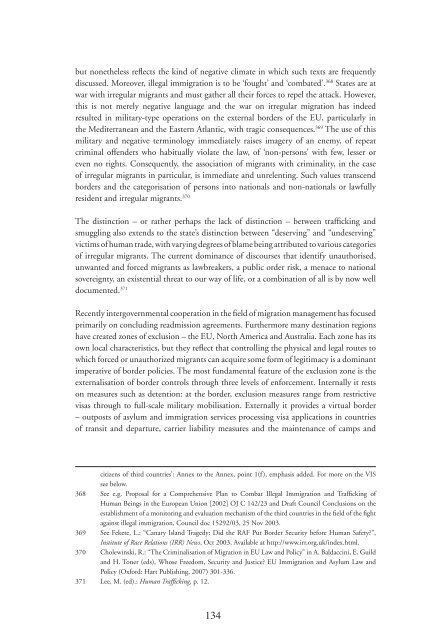Trafficking in human beings: human rights and ... - unesdoc - Unesco
Trafficking in human beings: human rights and ... - unesdoc - Unesco
Trafficking in human beings: human rights and ... - unesdoc - Unesco
Create successful ePaper yourself
Turn your PDF publications into a flip-book with our unique Google optimized e-Paper software.
ut nonetheless refl ects the k<strong>in</strong>d of negative climate <strong>in</strong> which such texts are frequently<br />
discussed. Moreover, illegal immigration is to be ‘fought’ <strong>and</strong> ‘combated’. 368 States are at<br />
war with irregular migrants <strong>and</strong> must gather all their forces to repel the attack. However,<br />
this is not merely negative language <strong>and</strong> the war on irregular migration has <strong>in</strong>deed<br />
resulted <strong>in</strong> military-type operations on the external borders of the EU, particularly <strong>in</strong><br />
the Mediterranean <strong>and</strong> the Eastern Atlantic, with tragic consequences. 369 The use of this<br />
military <strong>and</strong> negative term<strong>in</strong>ology immediately raises imagery of an enemy, of repeat<br />
crim<strong>in</strong>al offenders who habitually violate the law, of ‘non-persons’ with few, lesser or<br />
even no <strong>rights</strong>. Consequently, the association of migrants with crim<strong>in</strong>ality, <strong>in</strong> the case<br />
of irregular migrants <strong>in</strong> particular, is immediate <strong>and</strong> unrelent<strong>in</strong>g. Such values transcend<br />
borders <strong>and</strong> the categorisation of persons <strong>in</strong>to nationals <strong>and</strong> non-nationals or lawfully<br />
resident <strong>and</strong> irregular migrants. 370<br />
The dist<strong>in</strong>ction – or rather perhaps the lack of dist<strong>in</strong>ction – between traffi ck<strong>in</strong>g <strong>and</strong><br />
smuggl<strong>in</strong>g also extends to the state’s dist<strong>in</strong>ction between “deserv<strong>in</strong>g” <strong>and</strong> “undeserv<strong>in</strong>g”<br />
victims of <strong>human</strong> trade, with vary<strong>in</strong>g degrees of blame be<strong>in</strong>g attributed to various categories<br />
of irregular migrants. The current dom<strong>in</strong>ance of discourses that identify unauthorised,<br />
unwanted <strong>and</strong> forced migrants as lawbreakers, a public order risk, a menace to national<br />
sovereignty, an existential threat to our way of life, or a comb<strong>in</strong>ation of all is by now well<br />
documented. 371<br />
Recently <strong>in</strong>tergovernmental cooperation <strong>in</strong> the fi eld of migration management has focused<br />
primarily on conclud<strong>in</strong>g readmission agreements. Furthermore many dest<strong>in</strong>ation regions<br />
have created zones of exclusion – the EU, North America <strong>and</strong> Australia. Each zone has its<br />
own local characteristics, but they refl ect that controll<strong>in</strong>g the physical <strong>and</strong> legal routes to<br />
which forced or unauthorized migrants can acquire some form of legitimacy is a dom<strong>in</strong>ant<br />
imperative of border policies. The most fundamental feature of the exclusion zone is the<br />
externalisation of border controls through three levels of enforcement. Internally it rests<br />
on measures such as detention: at the border, exclusion measures range from restrictive<br />
visas through to full-scale military mobilisation. Externally it provides a virtual border<br />
– outposts of asylum <strong>and</strong> immigration services process<strong>in</strong>g visa applications <strong>in</strong> countries<br />
of transit <strong>and</strong> departure, carrier liability measures <strong>and</strong> the ma<strong>in</strong>tenance of camps <strong>and</strong><br />
citizens of third countries’: Annex to the Annex, po<strong>in</strong>t 1(f), emphasis added. For more on the VIS<br />
see below.<br />
368 See e.g. Proposal for a Comprehensive Plan to Combat Illegal Immigration <strong>and</strong> Traffi ck<strong>in</strong>g of<br />
Human Be<strong>in</strong>gs <strong>in</strong> the European Union [2002] OJ C 142/23 <strong>and</strong> Draft Council Conclusions on the<br />
establishment of a monitor<strong>in</strong>g <strong>and</strong> evaluation mechanism of the third countries <strong>in</strong> the fi eld of the fi ght<br />
aga<strong>in</strong>st illegal immigration, Council doc 15292/03, 25 Nov 2003.<br />
369 See Fekete, L.: “Canary Isl<strong>and</strong> Tragedy: Did the RAF Put Border Security before Human Safety?”,<br />
Institute of Race Relations (IRR) News, Oct 2003, Available at http://www.irr.org.uk/<strong>in</strong>dex.html.<br />
370 Cholew<strong>in</strong>ski, R.: “The Crim<strong>in</strong>alisation of Migration <strong>in</strong> EU Law <strong>and</strong> Policy” <strong>in</strong> A. Baldacc<strong>in</strong>i, E. Guild<br />
<strong>and</strong> H. Toner (eds), Whose Freedom, Security <strong>and</strong> Justice? EU Immigration <strong>and</strong> Asylum Law <strong>and</strong><br />
Policy (Oxford: Hart Publish<strong>in</strong>g, 2007) 301-336.<br />
371 Lee, M. (ed).: Human Traffi ck<strong>in</strong>g, p. 12.<br />
134

















